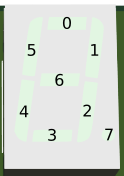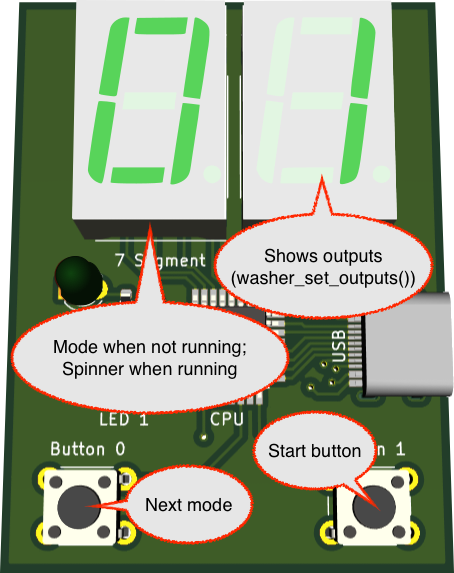Homework 6B
What’s due
- RISC-V Assembly Language Program: As with prior assignments, your completed code needs to be submitted (via GitHub) to Gradescope. A significant portion of the grade comes from passing unit tests.
- Questions: The GitHub submission needs to include completed answer to the questions in
questions.mdin the repo. - An in-person demo (during office hours) is required for full credit.
Setup
Create a repo via this link
The Wonder Washer: The Phinal Phase
SH Enterprises would like to boost sales via a cheaper (and simpler) model of their popular Wonder Washer (which has been re-branded to the Wonder Washer Deluxe). They have also noticed that the cost of a RISC-V CPU is quite a bit less than the cost of a FPGA. They’ve decided using a RISC-V microcontroller rather than an FPGA may further reduce the cost of the machine.
Since you’re an expert on Wonder Washer designs, they’d like you to design a simpler version of your prior work using RISC-V Assembly Language.
(Re)(Re)Design
Changes
- In order to reduce the cost, the UV sanitizer has been removed. This impacts both outputs and the available wash cycles.
- Just four wash cycles are included now:
ModeValueMode Name 000Regular Wash & Dry 010Regular Wash & Power Dry 011Power Wash 001Power Wash Warm - Unlike prior versions of the Wonder Washer, some phases of washing have different timing and speed than others, which is more efficient and leads to better washing cycles!
- The washer will include a progress display (spinning) to help users see the progress through each phase of washing. It will move twice as fast on the “Power” modes.
The times below are all described in units that will be appropriate for your testing (using seconds). Production machines will eventually update these values with something appropriate to satisfactorily wash dishes. They are described in terms of how the display behaves (either $ updates \times timePerUpdate$ or $cycles \times updatesPerCycle \times timePerUpdate$…This correspond pretty closely to spinner() function’s behavior and arguments)
Regular Wash & Dry
- Soap is released and hot water is used to wash the dishes for 3 seconds ($6 \times 0.5s$)
- Warm water (a mix of both hot and cold) is used to rinse the dishes for 6 seconds ($2 \times 6 \times 0.5s$)
- The air dryer is used to dry the dishes for 6 seconds ($2 \times 6 \times 0.5s$)
Regular Wash & Power Dry
- Soap is released and hot water is used to wash the dishes for 3 seconds ($6 \times 0.5s$)
- Warm water (a mix of both hot and cold) is used to rinse the dishes for 6 seconds ($2 \times 6 \times 0.5s$)
- Extra hot air is used with the air dryer to dry the dishes for 3 seconds ($6 \times 0.5s$)
Power Wash
- Soap is released and hot water is used to wash the dishes for 3 seconds ($6 \times 0.5s$)
- High pressure cold water is used to rinse the dishes for 3 seconds ($2 \times 6 \times 0.25s$)
Power Wash Warm
- Soap is released and hot water is used to wash the dishes for 3 seconds ($6 \times 0.5s$)
- High pressure warm water (a mix of both hot and cold) is used to rinse the dishes for 3 seconds ($2 \times 6 \times 0.25s$)
Implementation
- You’ll need to complete the
washcyclefunction (inwasher.s). Argumenta0will indicate the desired mode. When called,washcyclewill do an entire cycle of washing and then return. -
washcycleshould usedelayandspinnerfrom Homework 6A. - Outputs are controlled by calling
washer_set_outputs. The bits ofa0indicate values of all outputs.washer_set_outputs: # Parameters # a0 is set of control values to apply # bit 0: Soap (1 = on) # bit 1: Hot (1 = on) # bit 2: Cold (1 = on) # bit 3: HighPressure (1 = on) # bit 4: AirDry (1 = on) # bit 5: ExtraHotAir (1 = on) # Return value # none / undefined # Side effects # control values are simulated on digit 0 (right digit) of the 7-segement displayThe values will be displayed on the right digit of the simulated I/O board:

Workflow, Demo, and Gradescope
Workflow
- The project relies on
delay()andspinner()from the last assignment. Thedelay.sandspinner.sfiles are included, but you will need to copy your completed code into each. - A
washer_driveris provided which will allow you to run a wash cycle via the simulated 7-segment I/O board. The I/O is:

Demo
Gradescope
Gradescope will run several test cases to check for:
- Register conventions
- Expected sequence of outputs/controls/functions calls for each mode
- The expected sequence of outputs/controls/function calls for a sequence of mode 0, then 1, then 2, then 3.
Questions: questions.md
As in past assignments, complete the questions in questions.md
Submission
As with Homework 6A, you will need to commit and push work to GitHub and then go to Gradescope to “pull” the work over.
- Submission Link: Gradescope
